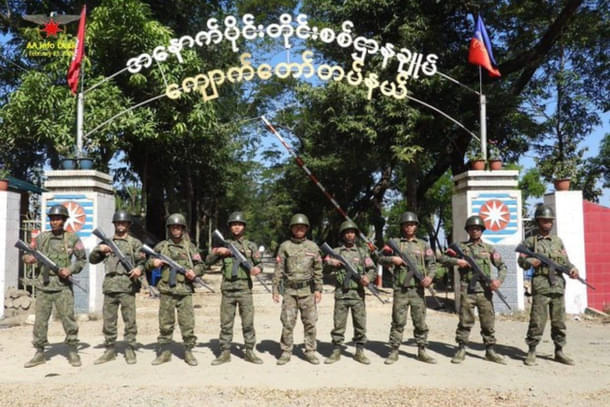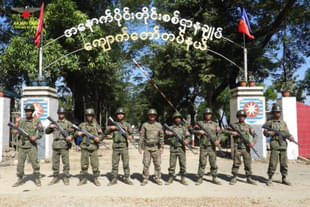World
How Recent Successes Of Rebel Forces In Myanmar’s Rakhine And Chin States Can Prove Advantageous For India
Jaideep Mazumdar
Dec 28, 2024, 12:46 PM | Updated 12:46 PM IST
Save & read from anywhere!
Bookmark stories for easy access on any device or the Swarajya app.


After facing severe setbacks in the eastern and central parts of the country, Myanmar’s ruling junta has lost control over at least 80 per cent of its western Chin state and almost the entire Rakhine state in the southwest to ethnic armed organisations (EAOs).
Both these states border India’s Mizoram and Manipur.
The Chin Brotherhood Alliance (CBA) announced last weekend that it has established control over 80 per cent of the Chin state that borders eastern Mizoram and southeastern Manipur. The CBA has defeated junta forces and taken over major towns and military garrisons.
The Arakan Army (AA) has also established control over almost the entire Rakhine state after the dramatic fall of the Myanmar army’s Western Command headquarters in Ann town. The AA has also captured the strategic Paletwa town in Chin state.
The CBA has said that junta troops who remain in Chin state’s capital, Hakha, and the towns of Falam, Tedim, and Thantlang are restricted to their barracks, and it is only a matter of time before these towns also fall.
The CBA has battled the junta forces over the past few weeks with the help of other EAOs, like the Yaw Defence Force and the Monywa People’s Defence Force. The AA has supported the CBA offensive with arms, reinforcements, and tactical advice.
The success of the EAOs has been accompanied by large-scale defections from the Tatmadaw, as the Myanmarese military is called. Many men and officers of the Myanmarese armed forces have either surrendered or joined the EAOs.
Faced with a severe shortage of personnel, the junta has resorted to forced conscription. But the fresh conscripts are joining the rebel EAOs in droves.
Security experts predict that the junta forces will be driven out completely from the Chin and Rakhine states by early next year.
What This Means for India
The fall of the Chin and Rakhine states to rebel EAOs, which are fighting the Myanmarese junta forces, presents a wonderful opportunity for India. That’s for three reasons.
First, India’s ambitious Kaladan Multimodal Transport Transit Project, which has been in limbo for the past few years, can be revived now.
Second, India can easily exploit the deep differences within the Chin resistance forces to neutralise the Kuki-Chin militant groups in Manipur and also repatriate the 70,000-odd Kuki-Chin refugees from Myanmar who are now sheltered in Mizoram.
Third, the latest developments in Myanmar, with the EAOs and citizens’ resistance groups — called the People’s Defence Forces (PDFs), which are affiliated to the anti-junta National Unity Government (NUG), comprising all opposition and exiled political parties — making steady territorial gains and defeating the junta forces, also presents India with a very good opportunity to increase its influence in Myanmar.
Kaladan Multimodal Transport Transit Project: The objective of this Rs 2,904-crore project is to transport goods from Kolkata to Mizoram through Myanmar, bypassing Bangladesh.
Goods will be transported by ship from Kolkata and other places on India’s eastern seaboard to Sittwe port in Rakhine state and then taken upstream along the Kaladan River to Paletwa in Chin state, from where they will be transported by road to Mizoram.
As part of this ambitious project, India has executed all the works, including dredging and construction of new jetties, at Sittwe, and developed the Paletwa river port.
Construction of the highway from Zorinpui in Mizoram to Paletwa has, however, been held up because of the ethnic conflict in Myanmar.
This transport and transit project is important because it offers another convenient route, apart from the existing one through the Chicken’s Neck corridor of North Bengal, to North East India.
Though a number of transit protocols have been signed for the transportation of goods through Bangladesh, they are shrouded in a lot of uncertainty now because of the current situation in that country.
India will need the help and cooperation of both the AA and CBA to get the Kaladan project going.
Now that both the AA and CBA have made stupendous gains and driven out the junta forces from most of the Rakhine and Chin states, India should quickly move to not only establish strong ties with both these EAOs but also to extend all help to them to consolidate their gains from their battles with the junta forces.
India should offer help to the AA and CBA to set up effective and efficient administrative machinery in their respective states. India’s governance institutions have a lot of experience in this regard and should offer their resources to the AA and CBA.
New Delhi has already renewed ties with the NUG and is actively engaged in strengthening them. The AA and CBA are allied to the NUG, and keeping the long-term interests of Myanmar in mind, India has to take a firm stand to support the NUG and withdraw support to the junta, which has become extremely unpopular in Myanmar.
Doing all this will secure the Kaladan project and put it on track. This project will ensure efficient and economical transportation of goods to the eastern parts of India’s North East, in the states of Mizoram, Manipur, Nagaland, and even eastern Arunachal Pradesh.
Dealing With Kuki-Chin Militants and Refugees: The CBA, which has won recent battles in Chin state against junta forces, has been engaged in fratricidal conflicts with other Kuki-Chin outfits — the Chin National Army (CNA) and the Zomi Revolutionary Army (ZRA).
The CBA was formed a year ago (on 30 December 2023) and has engaged in violent skirmishes with some other Kuki-Chin rebel groups since January this year.
The Kuki National Army (KNA), which is active in Manipur and is responsible for many attacks on Meiteis and security forces in that state, is an ally of the ZRA.
The success of the CBA in establishing its writ over most of the Chin state presents an opportunity for India to de-escalate the ethnic strife in Manipur and repatriate Kuki-Chin refugees from Mizoram.
Security and intelligence experts told Swarajya that New Delhi has established contacts with the CBA and is in the process of strengthening ties with them.
Once the CBA is befriended, it can be requested to facilitate the repatriation of the Myanmarese refugees who fled Chin state over the past two years.
New Delhi will be able to leverage its good ties with the CBA to launch a coordinated offensive against the KNA and neutralise it.
The KNA’s ranks in Manipur have been reinforced in recent months by CNA and ZRA cadres from Myanmar. These militants need to be driven out of Manipur, and the CBA can be a big help in that.
Neutralising the Kuki militants in Manipur is a prerequisite for ending the ethnic conflict in that state.
Gaining the Upper Hand Over China in Myanmar: China has, over the past two months, lost the trust and goodwill of the EAOs in Myanmar. It is also being viewed with a lot of suspicion now by the junta.
While it has been covertly supporting many of the EAOs in their war against the junta, China has overtly backed the junta-run government, called the State Administration Council (SAC), which is headed by junta chief, senior general Min Aun Hlaing.
China’s diabolic policy of running with the hares and hunting with the hounds has started backfiring in Myanmar ever since the EAOs, and the PDFs, started winning their battles with the junta forces and gaining control of vast areas to the east of Myanmar, bordering China.
Beijing realised that the downfall of the junta in Myanmar would put its investments and interests — the Belt and Road Initiative (BRI) projects, Chinese-run factories and mines, and the China Myanmar Economic Corridor — in severe jeopardy.
That’s why Beijing started putting pressure on the EAOs, especially the ones active in Kachin and Shan states, to stop their hostilities against the SAC and reach a ceasefire agreement with the junta.
China also asked the EAOs to hand over control of many territories that they had captured from the junta forces back to the junta. The EAOs haven’t complied and have also started turning against China.
At the same time, Beijing has asked the SAC to form a joint venture security company (comprising regular Chinese forces and the Myanmarese armed forces) to secure Chinese investments and interests in Myanmar.
Myanmar’s ruling generals, though dependent on China, have bristled at this proposal, which will compromise Myanmar’s sovereignty. As a result, the junta is also trying to distance itself, though without much success, from Beijing.
This scenario presents a good opportunity for India to deepen its engagements with the EAOs, as well as the NUG.
The NUG, which is headed by Aung San Suu Kyi’s National League for Democracy (NLD), has never been friendly with China. New Delhi, in a bid to maintain a strategic balance in Myanmar, has also kept the NUG at arm’s length despite many requests from the latter for help and support.
It is now time for New Delhi to completely reverse the policy of ‘limited engagement’ with the NUG, which is being backed by Western countries and also the Southeast Asia bloc ASEAN.
With the junta forces in Myanmar facing debilitating defeats and the EAOs and PDFs gaining control over vast swathes of territory in east, north, west and central Myanmar, India needs to step up its engagement with the NUG.
Good ties with the NUG, as well as the EAOs, which have fallen out with China recently, will help India not only to secure its own interests in Myanmar but also counter China and have friends on its eastern flank.




